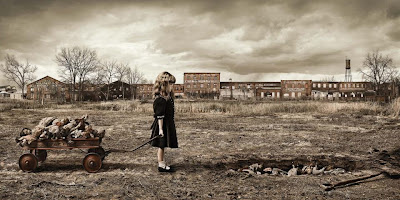Discovery
The woman in this image is discovering things as she is walking down the road. The darkness emphasizes that there are things to discover, for example how long is the road. It is a straight, direct angle which doesn't show the entire picture, but that's the idea. She is located in the middle of the rule of thirds and the reason for this is because she is not the main attention of the image, but what she's discovering is more important.

Mood
This image shows a happy mood. The lighting is bright and the color texture is dominated by a smooth white. This helps portray the content mood as well as the position of the camera. Since it's locate to the side of the baby it creates a side-angle allowing the image to have the baby's reflection too. The mirror is said to be a reflection of how people truly feel and the smile on the baby's face indicates her happiness. Finally there are no shadows suggesting there is no negativity vibe into the baby's life.
Backstory
The color represents the exact
situation in this image. The obscurity has a double entendre, it is dark because it's probably in the afternoon, but the backstory is that she is barring her mistreated dolls. She is probably going through some tough times, depression or even mental illness. The lighting show many shadows that tell the backstory of this image, which is well set up by the long shot.
Character
The colors of this picture is basically the element that helps define the character of the child. All the bright colors represent the spirit of a child; they're full of energy and fun. However, the lighting implies that there is a darkest side to this child, the shadow on the half of the face plus all the obscurity behind her indicate she's not completely pure, innocent. The Medium Close up and the way she's looking at the camera describe her unique character as well as all that was mention previously.
Goal
The dog is scared of the bubbles and his goal is to run away from them. The medium shot captures perfectly his emotions. There is rack focus, the dog and the bubbles are on focus while the background is blurry. There entire image is lighted evenly creating the sense that it's day time.
Obstacle
The obstacle in this image is the loneliness this baby turtle faces. He's alone in the beach and since he looks small and baby turtle he could be in danger. The long shot provokes the sense of how big the beach is and how small the turtle is.
There is low lighting indicating the night is about to take over. Everything is on focus.
Relationship
The relationship is with oneself. The water us used a mirror that shows you a reflection of yourself. Your relationship with your own persona. The lighting is interesting because it creates some shadows, but it's bright at the same time. The water in the image distorts the image and add a different perspective.
Setting
The lighting strongly dominated the setting of this picture. The bright white light illuminates the image, but similarly it brings darkness. It is contrasting white and black colors and creates a balanced setting. Only two colors, two options; good or evil. Also given that is located in nature, the setting of the forest is different from the ideal forest people create in their heads.
Time
This image shows contrasts may elements such as light, focus, and speed of time. The focus is in the man, but also in the train. The speed of the train is faster than the man's and even though they are so close, he missed the train by a small period of time. Time can go so fast (the train), but at the same time it can go slow (man). Additionally there light and darkness in this picture.
Unknown
The lighting dominates this image, it creates a deep meaning. The white light behind the woman is an unknown and the plants around her do not help solve the mystery. She's centered in the rule of thirds and the front angle suggest she's into nature.




























